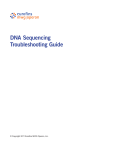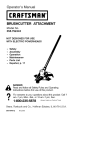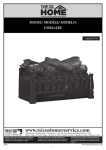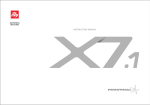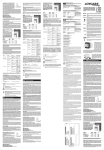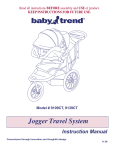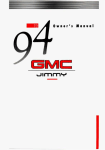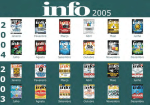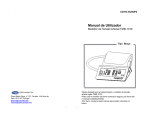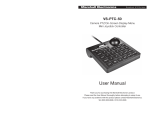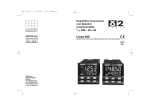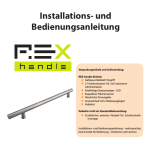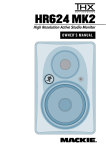Download User Manual - Hopkins Medical Products
Transcript
User Manual Blood Pressure Monitor User Manual Manual User RELATED ITEMS TMB-1018 Blood Pressure Monitor Arm Type TMB-1018 Hopkins® IMPACT Digital Arm BP • Replacement Adult Size Cuff #526019 • Large Adult Size Cuff #526020 • Hopkins ® Flex Temp Thermometer #579420 Arm Type Item #526018 • Hopkins ® Wave t m Pulse Oximeter #594029 Hopkins® IMPACT Digital Arm BP Thank you very much for selecting TRANSTEK Blood Pressure Monitor TMB-1018. To use the monitor correctly and safely, please read the manual thoroughly. Please well keep this manual in order to reference in future. ZHONGSHAN TRANSTEKELECTRONICES CO.,LTD Jinbiao, Minzhong, Zhongshan,528441,Guangdong, China 5 Greenwood Place • Baltimore, MD 21208 1-800-835-1995 • FAX: 410-484-4036 w w w. h m p o n l i n e . c o m Thank you for selecting the Hopkins® IMPACT Digital Arm BP #526018. Thank you very for selecting Blood Pressure To use this BPmuch monitor correctly TRANSTEK and safely, please read thisMonitor entire TMB-1018. manual thoroughly and keep it for your reference. To use the monitor correctly and safely, please read the manual thoroughly. Please well keep this manual in order to reference in future. INDEX INTRODUCTION ♥ Features INTRODUCTION ................................................................................................. 1 •Measures Systolic Blood Pressure •Safety information •LCD display •Monitor components •Measures Diastolic Blood Pressure •Measures Pulse Rate BEFORE YOU START ..................................................................................... 4 •Installing and replacing batteries •Setting date and time •Retains historic records of up to 60 previous measurements •Large 5.5” x 1.5” bright LCD display ♥ Safety Information The following symbols may be used in the user manual, product labeling, or on other components. They are the requirement of standard and use. MEASUREMENT ................................................................................................. 7 •Positioning the cuff •Taking a measurement Caution: consult accompanying documents Type B applied part •Recalling records •Deleting records CE Mark: conforms to essential requirements of the Medical Device Directive 93/42/EEC DISPOSAL: Do not dispose this product as unsorted municipal waste. Collection of such waste separately for special treatment is necessary. INFORMATION FOR THE USER ..................................................................... 11 Manufacturer Direct current •Tips for operation •Maintenance Specifies serial number Authorized Representative in the European Community RECALLING RECORDED MEASUREMENTS .............................................. 9 ABOUT BLOOD PRESSURE ........................................................................... 13 •What are systolic and diastolic pressure? •What is normal blood pressure? •Why does my blood pressure fluctuate throughout the day? •Why is the reading I get from a healthcare provider different from the ones I take at home? •Which arm should I use to take my blood pressure? ! CAUTION This device is for adult use only. This device is intended for non-invasive measuring and monitoring of arterial blood pressure. It is not intended for use on extremities other than the arm or for functions other than obtaining a blood pressure measurement and pulse rate. TROUBLESHOOTING ...................................................................................... 15 SPECIFICATIONS ............................................................................................. 16 WARRANTY INFORMATION ......................................................................... 21 Thank you for selecting the Hopkins® Digital IMPACT Arm BP (Item #526018). This monitor features blood pressure measurement, pulse rate measurement, and an auto-save function. Do not confuse self-monitoring with self-diagnosis. This unit allows you to monitor your blood pressure. Do not begin or end medical treatment based solely on self-monitoring, consult a physician for treatment advice. If you are taking medication, consult your physician to determine the most appropriate time to measure your blood pressure. Never change a prescribed medication without consulting your physician. This unit is not suitable for continuous monitoring during medical emergencies or operations. If the cuff pressure exceeds (300 mmHg), the unit will automatically deflate. Should the cuff not deflate when pressures exceeds (300 mmHg), detach the cuff from the arm and press the START/STOP button to stop inflation. To avoid measurement errors, carefully read this manual before using this device. Readings taken by the #526018 are equivalent to those obtained by a trained observer using the cuff and stethoscope auscultation method. This device is not AP/APG equipment and not suitable for use in the presence of a flammable anesthetic mixture with air, or with oxygen, or nitrous oxide. This manual contains important safety and care information, and provides step by step instructions for using this product. Read this manual thoroughly before using this product Please avoid strong electromagnetic fields as they may interfere with or damage this device. Always check this device to make sure that it is in proper working condition before use. 1 INTRODUCTION INTRODUCTION INTRODUCTION INTRODUCTION INTRODUCTION INTRODUCTION INTRODUCTION SYMBOL DESCRIPTION INTRODUCTION EXPLANATION INTRODUCTION LCD display signal INTRODUCTION Systolic blood pressure High pressure result SYMBOL DESCRIPTION EXPLANATION INTRODUCTION INTRODUCTION LCD display signal LCD display signal ♥ LCD Display Diastolic pressure pressure Systolic blood blood pressure High Low pressure resultresult LCDLCD display signal display signal LCD display signal LCD display signal LCD display signal LCD display signal Pulse Pulse/minute Diastolic blood pressure Low pressure result LCD display display signal LCD signal Deflating CUFF air Pulse Pulse/minute is exhausting of deflating Time (hour:minute) Deflating TimeMemory (hour:minute) INTRODUCTION INTRODUCTION LCD display signal Memory INTRODUCTION Monitor componen Monitor components ♥ Monitor Components INTRODU INTRODUCTION INTRODUCTION INTRODUCTION AIR HOSE DC POWER SOCKET INTRODUCTION INTRODUCTION INTRODUCTION INTRODUCTION INTRODUCTION DC POWER SOCKET CUFF Monitor components Monitor components Monitor components Monitor components SET/UP BUTTON Monitor components AIR HOSE Monitor components START/OFF BUTTON Monitor components CUFF CUFF SET/UP BUTTON CUFF CUFF CUFF Monitor components MEM/DOWN BUTTON CUFF CUFF Monitor components AIR HOSE START/OFF BUTTON AIR AIR HOSE HOSE LCD DISPLAY AIR HOSE AIR HOSE CUFF AIR HOSEMEM/DOWN BUTTON AIR HOSE CUFF AIR HOSE LCD DISPLAY CUFF BATTERY COMPARTMENT AIR HOSE Currently If “M”time shows, the displayed measurement AIR HOSE INTRODUCTION Component list of SYMBOL DESCRIPTION EXPLANATION BATTERY COMPARTMENT values is from the memory. pressure measuring system If “M”For shows, the displayedtomeasurement AIR CONNECTOR PLUG result instructions,refer Page 9 Systolic blood pressure High pressure time CUFFCurrently air is exhausting of deflating Component 1 Cuff list of CUFF TUBING EXPLANATION values is from the memory. pressure measuring system DCMicro POWER SOCKET DESCRIPTION EXPLANATION AIR CONNECTOR 2 Control Unit AIR CONNECTOR PLUG mmHg Measurement Unit of the 9blood pressure Diastolic blood pressure Low pressure result For instructions,refer to Page 1 Cuff3 Amplifier Monitor components PLUG Systolic blood BP pressure HighHigh pressure resultresult (1mmHg=0.133kPa) pressure SYS Systolic 2 Micro Control Pulse/minute 4 Air pipe Unit mmHg Measurement Unit of the blood pressure Pulse DC POWER SOCKET SYMBOL DESCRIPTION EXPLANATION DC SOCKET SYMBOL DESCRIPTION EXPLANATION DC POWER POWER SOCKET SYMBOL DESCRIPTION EXPLANATION DC POWER SOCKET SYMBOL DESCRIPTION EXPLANATION DC POWER SOCKET SYMBOL DESCRIPTION EXPLANATION 3 Amplifier CUFF kPa Measurement Unit of the blood pressure 5 Pump (1mmHg=0.133kPa) DC SYMBOL DESCRIPTION EXPLANATION Diastolic blood pressure Low pressure result DC POWER SOCKET SYMBOL DESCRIPTION EXPLANATION Diastolic BP Low pressure result Deflating CUFF air is exhausting of deflating DIA BP CATEGORY Systolic blood pressure High pressure result SET/UP BUTTON 4 Air pipe Systolic blood pressure High pressure result (1kPa=7.5mmHg) Systolic blood pressure High pressure result 6 Valve DC POWER SOCKET SYMBOL DESCRIPTION EXPLANATION Systolic High pressure result AIR HOSE Systolicblood bloodpressure pressure High pressure result LCD DISPLAY INDICATOR Systolic blood High pressure result kPa Measurement Unit the blood pressure 5 PumpDCBUTTON Systolic blood pressure Pulse/minute High pressure resultofpressure START/OFF POWER SOCKET SYMBOL Pulse DESCRIPTION EXPLANATION Time (hour:minute) Currently time Diastolic blood pressure Low pressure Pulse per Minute (Beats per Minute) Systolic blood pressure High pressure result DC POWER SOCKET SYMBOL DESCRIPTION EXPLANATION Diastolic blood pressure Low pressure result Pul/ min Pulse (1kPa=7.5mmHg) Diastolic blood pressure Low pressure result Low battery Batteries are low and needresult to be replaced 6 Valve Diastolic blood pressure Low pressure result Diastolic blood pressure Low pressure result MEM/DOWN BUTTON SET/UP BUTTON List SET/UP BUTTON Diastolic blood pressure Deflating CUFF is exhausting of deflatingLow pressure result Systolic blood Highair pressure result SET/UP SET/UP BUTTON Diastolic bloodpressure pressure Low pressure result BUTTON SET/UP BUTTON SET/UP BU Memory If “M”LCD shows, the displayed measurement Pulse Pulse/minute Systolic blood pressure High pressure result result DISPLAY Pulse Pulse/minute START/OFF BUTTON SET/UP BUTTON Diastolic blood pressure Low pressure START/OFF BUTTON Pulse Pulse/minute Pulse Pulse/minute Shocking willand result in inaccurate Pulse remainding Pulse/minute 2.Cuff (Type B applied part) (AC2232-01) 1.Blood Pressure Monitor LowBattery battery Batteries are need to bePulse/minute replaced START/OFF BUTTONBUTTON Low Batteries areShocking low andlow need to be replaced START/OFF BUTTON Pulse List SET/UP START/OFF BUTTON values is from the memory. Time (hour:minute) time START/OFF Diastolic blood pressure Currently Low pressure result Pulse Pulse/minute MEM/DOWN BUTTON START/OFF BUTTON MEM/DOWN BUTTON Deflating Low CUFF of air is exhausting of deflating MEM/DOWN BUTTON (TMB-1018-A) Diastolic blood pressure pressure result AIR CONNECTOR PLUG SET/UP MEM/DOWN BUTTON Deflating CUFF air is exhausting BUTTON Pulse Pulse/minute MEM/DOWN BUTTON BATTERY COMPARTMENT For instructions,refer toLCD Page 9 Deflating CUFF air is of deflating deflating START/OFF BUTTON Deflating CUFF air ofof deflating Deflating CUFF airisof isexhausting deflating MEM/DOWN Shocking remainding Shocking willexhausting result inexhausting inaccurate 2.Cuff (Type B applied part) (AC2232-01) 1.Blood Pressure Monitor DISPLAY Average The average blood pressure SET/UP BUTTON Deflating CUFF air is exhausting of deflating MEM/DOWN BUTTON LCD DISPLAY Pulse Pulse/minute LCD DISPLAY Deflating CUFF air exhausting ofmeasurement deflating If “M” shows, the displayed LCD DISPLAY START/OFFlist BUTTON LCD DISPLAY Millimeters MercuryTime Measurement unitisof blood pressure mmHg Memory MEM/DOWN BUTTON LCD DISPLAY Component of (hour:minute) Currently time Pulse Pulse/minute Time (hour:minute) Currently time Deflating CUFF air is exhausting of deflating (TMB-1018-A) LCD DISPLAY START/OFF BUTTON Time (hour:minute) Currently time mmHg Measurement Unit of the blood pressure Time Currently time values isTime from the memory. Time(hour:minute) (hour:minute) Currently time MEM/DOWN BUTTONsystem Recalling The willpressure be Currently time Average The average of blood BATTERY COMPARTMENT LCD DISPLAY BATTERY pressure measuring Deflating CUFF air erecords is (hour:minute) exhausting of showed deflating COMPARTMENT Time (hour:minute) Currently time BATTERY COMPARTMENT AIR CONNECTOR (1mmHg=0.133kPa) PLUG BATTERY COMPARTMENT MEM/DOWN BUTTON BATTERY COMPARTMENT For instructions,refer to Page 9 thevalue If “M” shows, the displayed measurement Deflating CUFF air is exhausting of deflating BATTERY COMPARTMENT LCD DISPLAY Memory If “M” shows, displayed measurement Time (hour:minute) Currently time Memory If “M” shows, the displayed measurement 1 Cuff BATTERY COMPARTMENT Memory If “M” shows, the displayed measurement list of Memory If If“M” shows, the displayed measurement Memory “M” shows, the displayed measurement Component list of Irregular heartbeat Arrhythmia Recalling The erecords will be showed is fromvalues the memory of recorded measurements Component list ofComponent Memory If “M” shows, the displayed measurement LCD DISPLAY BATTERY COMPARTMENT2 Micro Time (hour:minute) Currently time Component listlistofof Component DC POWER SOCKET SYMBOL Memory DESCRIPTION EXPLANATION values is from the memory. Memory If “M” shows, the displayed measurement is from the memory. Control Unit Compone kPa Measurement Unit of the blood pressure values isvalues from the memory. pressure measuring syste mmHg Measurement Unit of the blood pressure values is from the memory. Time (hour:minute) Currently time is from the memory. Component list of pressure measuring system (See page 9 for instructions) BATTERY COMPARTMENT pressure AIR CONNECTOR PLUG measuring systemsystem Memory If “M” shows, the displayed measurement valuestoisPage from 9the memory. pressure measuring AIR PLUG pressure measuring system For instructions,refer values isFor from the memory. For instructions,refer to Page 9 AIR CONNECTOR CONNECTOR PLUG PLUG 3 Amplifier Component list of pressure m AIR CONNECTOR (1kPa=7.5mmHg) AIR CONNECTOR PLUG For instructions,refer to Page 9 Grade The grade of the blood pressure. BATTERY COMPARTMENT Systolic blood pressure High pressure result 1 Cuff (1mmHg=0.133kPa) Irregular heartbeat For instructions,refer to Page 9 Arrhythmia instructions,refer to Page 9 pressure measuring system 1 Cuff AIR CONNECTOR PLUG Memory If “M” shows, the displayed measurement 1 Cuff values is from the memory. For instructions,refer to Page 9 3. 4*AAA alkaline batteries 4.User manual AIR CONNECTOR PLUG 1 Cuff 1 Cuff Component list of2 Micro Page 9 4 Air pipe measuring pressure system Cuff Memory IfFor “M” shows, the displayed The unit is instructions,refer inflating with air to to obtain the For tomeasurement Page 13 Control 1Unit 1 Cuff 2 Micro Unit AIR CONNECTOR PLUG values is instructions,refer from the memory. mmHg Measurement Unit of the blood pressure list Control of Inflating 2 Micro2Control Control Unit For instructions,refer to Page 9the mmHg Measurement Unit of the blood pressure Unit 2Micro Micro Control Unit mmHg Measurement Unit of the blood pressure pressure measuring system kPa Measurement of the blood pressure Low battery Batteries are low and need to be replaced 5 Component Diastolic blood pressure Low pressure result Grade The grade ofUnit the blood pressure. Pump mmHg Measurement Unit ofofthe blood mmHg Unit bloodpressure pressure required level ofMeasurement pressure 1 Cuff 2 Micro C values is from the memory. List 3 Amplifier AIR CONNECTOR PLUG mmHg Measurement Unit of the blood pressure 2 Micro Control Unit 3 Amplifier 3. 4*AAA alkaline batteries 4.User manual For instructions,refer to Page 9 (1mmHg=0.133kPa) pressure measuring system 3 Amplifier mmHg Measurement Unit of to thePage blood pressure (1mmHg=0.133kPa) 3Amplifier Amplifier (1mmHg=0.133kPa) AIR CONNECTOR PLUG 1SET/UP Cuff 3BUTTON (1kPa=7.5mmHg) For instructions,refer instructions,refer 6 Valve (1mmHg=0.133kPa) (1mmHg=0.133kPa) 2 Micro Control Unit 3 Amplifie For to Page 913pressure 4Pressure Air pipe Monitor mmHg Measurement Unit the 3 Amplifier Air pipe Pulse Pulse/minute 14 Cuff Shocking remainding Shocking will result in inaccurate 4 Air pipe 1.Blood (1mmHg=0.133kPa) START/OFF BUTTON The unit is deflating and theofair is blood being (1mmHg=0.133kPa) 4 Air pipe 4 Air pipe 2 Micro Control Unit 3 Amplifier 4 Air pipe kPa Measurement Unit of the blood pressure Deflating mmHg 5 Pump kPa Measurement Unit of the blood pressure (1mmHg=0.133kPa) 4 Air pipe 5 Pump kPa Measurement Unit of the blood pressure 2 Micro Control Unit exhausted from thelow cuff 5 Pump kPa Measurement Unit ofof the blood kPa Measurement Unit the bloodpressure pressure Low battery Batteries are andofneed to be replaced 5 5Pump (TMB-1018-A) BUTTON Pump mmHg Measurement Unit the pressure 3MEM/DOWN Amplifier Measurement Unit of the blood pressure List Deflating CUFFkPa air is exhausting ofblood deflating 4 Air pipe 5 Pump (1kPa=7.5mmHg) (1mmHg=0.133kPa) 6 Valve kPa Measurement Unit of the blood pressure (1kPa=7.5mmHg) 5 Pump Average The average of blood pressure Valve (1kPa=7.5mmHg) 36 6 Valve (1kPa=7.5mmHg) (1kPa=7.5mmHg) 6 6Valve Valve LCD DISPLAY (1mmHg=0.133kPa) 4 Amplifier Air pipe kPa Measurement Unitinofinaccurate the blood pressure (1kPa=7.5mmHg) 5 Pump 63Valve 2 (1kPa=7.5mmHg) Shocking remainding Shocking will result 6 Valve 2.Cuff (Type B applied part) (AC2232-01) 1.Blood Pressure Monitor 4 Air pipe Time (hour:minute) The current time (set by user) Time (hour:minute) Currently are timelow kPa Measurement Unit of the blood pressure 5 Valve Pump Low battery Batteries are low and needRecalling to be replaced (1kPa=7.5mmHg) 6 Low Batteries and need to be replaced The erecords will be showed List Low battery battery Batteries are low and need to be replaced List Low battery Batteries are low and need to be replaced kPa Measurement Unit of the blood pressure Low battery Batteries are low and need to be replaced (TMB-1018-A) BATTERY COMPARTMENT 56 Pump Low battery to beList replaced (1kPa=7.5mmHg) List 3 Valve Low battery Batteries are low and need to beBatteries replaced are low and need List Average The average ofmay blood pressure List (1kPa=7.5mmHg) Memory Ifremainding “M” shows, the displayed measurement 6Component Valve Inaccurate readings occur if unit isbe hit,replaced Shocking Shocking will result in inaccurate 2.Cuff (Type B applied part) (AC2232-01) 1.Blood Pressure Monitor Shocking remainding Shocking will result in inaccurate Low battery Batteries are low and need to Irregular heartbeat Arrhythmia 2.Cuff (Type B applied part) (AC2232-01) 1.Blood Pressure Monitor list of Shocking remainding Shocking will result in inaccurate Shock Warning 2.Cuff (Type B applied part) (AC2232-01) 1.Blood Pressure Monitor List Shocking remainding Shocking will result in inaccurate Shocking remainding will result in inaccurate will result in inaccurate 2.Cuff BBapplied part) 1.Blood 2.Cuff(Type (Type applied part)(AC2232-01) (AC2232-01) 1.BloodPressure PressureMonitor Monitor Shocking remainding values isShocking from the memory. shaken, or otherwise shocked 2.Cuff (Type Bsystem applied part) (AC2 Monitor Low battery Batteries are low and to beShocking replaced Shocking remaindingdropped, Shocking will result in need inaccurate (TMB-1018-A) 2.Cuff Pressure (Type B applied part) (AC2232-01) 1.Blood Pressure Monitor 1.Blood Recalling The erecords will beand showed pressure measuring List (TMB-1018-A) (TMB-1018-A) Low battery Batteries are low need to be replaced AIR CONNECTOR PLUG (TMB-1018-A) (TMB-1018-A) Average The average of blood pressure Shocking remainding Shocking will result in inaccurate Grade The grade of the blood pressure. For instructions,refer to Page 9 2.Cuff (Type B applied part) (AC2232-01) 1.Blood Pressure Monitor List Average The average of blood pressure (TMB-1018-A) Average The average of bloodofof pressure 1 Cuff 3. 4*AAA alkaline batteries Average The blood (TMB-1018-A) Average Theaverage average bloodpressure pressure Shocking remaindingThe average Shocking result in pressure inaccurate Average The average of blood pressure 2.Cuff (Type 1.Blood Pressure Monitor For instructions,refer to Page 13 B applied part) (AC2232-01) Average of thewill blood pressure measurements Average The average of blood Irregular heartbeat Arrhythmia (TMB-1018-A) Shocking remainding Shocking will result inshowed inaccurate 2 Micro Control Unit 2.Cuff (Type B applied part) (AC2232-01) 1.Blood Pressure Monitor Recalling The erecords will be showed mmHg Measurement Unit of the blood pressure Average average of blood pressure Recalling The erecords will be (TMB-1018-A) Recalling The erecords will be showed Recalling The will Theerecords erecords willbebeshowed showed 3 Amplifier Recalling The erecords will be showed Average Recalling The average of blood pressure (TMB-1018-A) (1mmHg=0.133kPa) Grade The grade of the blood pressure. Recalling The erecords will be showed Average The average ofwill blood pressure 3. 4*AAA alkaline batteries 4.User manual Irregular heartbeat Arrhythmia 4 Air pipe Recalling The stored records are being retrieved Recalling The erecords betoshowed Irregular heartbeat Arrhythmia Irregular heartbeat For instructions,refer Page 13 Arrhythmia Irregular heartbeat Arrhythmia Irregular heartbeat Arrhythmia Irregular heartbeat Arrhythmia Recalling The erecords will kPa Measurement Unitbeofshowed the blood pressure 5 Pump Irregular heartbeat Arrhythmia Recalling erecords will blood be showed Grade The grade of the blood pressure. Grade The grade of the pressure. Irregular heartbeat Arrhythmia (1kPa=7.5mmHg) Grade Grade The grade of the The blood pressure. 6 Valve The grade of the blood pressure. 3. 4*AAA alkaline batteries 4.User manual Grade The grade of the blood pressure. 3. 4*AAA alkaline batteries 4.User manual Grade The grade of the pressure. 4*AAA alkaline batteries 4.User manual 2detected Irregular Heartbeat Irregular heartbeat (arrhythmia) instructions,refer to Page 13 blood3. Irregular heartbeat 3.3. 4*AAA alkaline manual Arrhythmia 4*AAA alkaline batteries 4.User manual ® batteries Grade The grade of the For blood For instructions,refer to Page #526018 Hopkins IMPACT Adult Digital Cuff AAA Batteries 3. 4.User 4*AAA4.User alkaline batteries 4.UserFour manual For instructions,refer to pressure. Pageto13 13 For instructions,refer 1313 For instructions,refer toPage Page Irregular heartbeat 3.Page 4*AAA alkaline batteries manual Arrhythmia Grade The grade of the blood pressure. For instructions,refer to 13 Low battery Batteries are low andto need to 13 be replaced For instructions,refer Page Digital BP Monitor 3. List 4*AAA alkaline batteries 4.User manual Cuff Circumference: 8.5” - 12.5” Grade The grade of the blood pressure. For instructions,refer to Page 13 BP Category Blood The pressure level reading 3. 4*AAA alkaline batteries 4.User manual(22cm - 32cm) Grade grade of the blood pressure. For instructions,refer Page 13 3 Shocking remainding(See page Shocking will result intoinaccurate 3. 4*AAAPressure alkaline batteries 4.User manual 2.Cuff (Type B applied part) (AC2232-01) 1.Blood Monitor Indicator 13 for instructions) For instructions,refer to Page 13 SYMBOL DESCRIPTION SYMBOL LCD display signal 2 22 2 22 2 Average Recalling 2 The average of blood pressure The erecords will be showed (TMB-1018-A) AAA AAA AAA ♥ Parts Included AAA 2 3 3 3 33 the right battery and special power adapter. MEM START STOP BEFORE YOU START The installment and replacement of battery BEFORE YOUYOU STARTSTART BEFORE ♥ 1.Slide off the battery cover. The Choice of Battery 2.Install the batteries by 1.Battery powered mode: The Choice ofmatching Battery 4*AAA alkaline batteriesas shown. the6VDC correct polarity, 2.AC adaptor powered mode: 1.Battery mode: 3.Replace the powered cover. 100-240V~, 50-60HZ,400mA Installing the Batteries BEFORE YOU START BEFORE YOU START 2.Press the “MEM” to change the [YEAR]. Setting Date, time and measurement unitDate ♥ Setting the and Time Setting Date, time and measurement unit It is important to set the clock before using your blood pressure monitor, so that a time stamp can be assigned to eachto record It is important set that the clock before using your blood pressure monitor is stored in the memory. (year :2000—2050,time:24 H) It is important to set the clock before using your blood pressure so that a time stamp can be assigned to each record stored in the memory. 4*AAA alkaline batteries (Can6VDC be supplied by AC adaptor model 2.AC adaptor powered mode: UE08WCP-060100SPA only!) Please unplug the adaptor to depart from 100-240V~, 50-60HZ,400mA AC adaptor 1.When the unit is off, hold pressing “SET” for 3 seconds to enter the mode for year setting. 1. Slide off the utility battery the using power. cover on the back of the unit. (Can be supplied by AC adaptor model the below happen Replace the batteries whenever CAUTION UE08WCP-060100SPA only!) 2. InstallInthe byeffect matching the polarity, as shown above. orderbatteries to get the best and protect you correct monitor,please use The shows the rightPlease battery and special power adapter. the adaptor to depart from AAA size) Always use the unplug correct battery type (4 alkaline AC adaptor dims theThe usingdisplay utility power. The installment and replacement of battery The display does not light up 3. Replace the 1.Slide off battery the battery cover. cover. CAUTION 2.Press the “MEM” to change the [YEAR]. 2.Install the batteries by matching the correct polarity, as shown. In order to get the best 3.Replace the cover. monitor, so that a time stamp can be assigned to each record that is stored in the memory. (year :2000—2050,time:24 H) (The year can be set to anywhere between 2000 and 2050.) MEM Replace the batteries when any ofso the following occurs: The old battery is harmful to the environment, please disposal with other daily trash. Replace the batteries whenever the below happen The installment and replacement of battery Remove the old battery from the device and follow your local recycling guidelines. shows shows 1.Slide off the battery cover. The display dims •TThe he display dims 2.Install the batteries display does not lightby up matching the correct shown. •The displaypolarity, does notas light up CAUTION 3.Replace the cover. Remove batteries if the device is not likely to be used for some time. 4 3.When you get the right year, press “SET” to set down and turn to next step automatically. The old battery is harmful to the environment, so please disposal with other daily trash. START STOP SET 1.When the unit is off, 1. When the off, 3.When youpressing get unit the is“SET” hold START STOP MEM SET right year, press press hold the to “SET” forand 3 seconds enter “SET” to for set the mode for year button 3down seconds to and turn to next step setting. enter the mode settings. automatically. effect and protect you monitor,please use CAUTION the right battery and special power adapter. Remove batteries if the device is not likely to be used for some time. •TThe he SET BEFORE YOU START MEM MEM START STOP MEM SET START STOP START STOP SET SET 2.Press the “MEM” to change the [YEAR]. 2. Press the “MEM” button to advance to the current [YEAR]. MEM START STOP 5 SET Remove the old battery from the device and follow your local recycling guidelines. 4 ! CAUTIONReplace the batteries whenever the below happen •If this device will be stored for an extended period of time, please remove the batteries The shows in order to avoid corrosion. The display dims •Used batteries are harmful to the environment, so please dispose of appropriately. Remove the old batteries the device andnot follow yourup local recycling guidelines Thefrom display does light •Battery corrosion is not covered under your three year limited warranty. CAUTION 5 MEM START STOP SET MEM START STOP SET you get the 3.3.When Press “SET” when press youright haveyear, reached the “SET” to set down correct year to save your and turn to next step choice and advance to automatically. the next step. Remove batteries if the device is not likely to be used for some time. The old battery is harmful to the environment, so please disposal with other daily trash. Remove the old battery from the device and follow your local recycling guidelines. 4 4 55 SYMBOL Systolic blood pressure Tie the cuff Tie result the cuff High pressure Diastolic blood pressure Low pressure the result position the tube off-center DESCRIPTION 4.Repeat step 2 and 3 to set the [MONTH] and [DAY]. BEFORE YOU START BEFORE YOU START BEFORE YOU START 4.Repeat step 2 and 3 to set the [MONTH] [DAY]. START and STOP E M EXPLANATION 1.Tie the cuff on your upper arm, 1.Tie the cuff on your upper arm, toward the inner side of arm in ♥Pulse/minute Positioning Cuff the position thethe tube off-center S E UR EA M MEASUREMENT MEASUREMENT MEASUREMENT line with the little finger. TieCUFF the cuff the inner side of arm in Deflating air istoward exhausting of deflating 4. Repeat steps 2 and 3 to set the [MONTH] and [DAY] LCD DISPLAY START STOP START STOP line with the little finger. 4.Repeat step 2 and 3 to set the [MONTH] and [DAY]. 1. Make sure the air tube is connected BEFORE YOU START MEASUREMENT Tie the Time (hour:minute) Currently time cuff 1.Tie thesecurely cuff on your BATTERY COM to theupper unit. arm, the position off-center Memory If “M” shows,the thetube displayed measurement 1.Tiethe cuff your upper values isthe from theon memory. 4.Repeat step 2 and 3 to set the [MONTH] and [DAY]. toward inner side of arm in arm, Tie the cuff AIR CONNECTOR PLUG the position the tube off-center For instructions,refer to Page 9 START STOP START STOP line with the little finger. START STOP START STOP 2. Fasten the cuff on of your leftinupper toward the inner side arm mmHg Measurement Unit of theit blood arm and position so thatpressure the tube 5.Repeat step 2START andSTOP3 START to set STOP the [HOUR] and [SECOND]. 1.Tie the cuff on your upper arm, START STOP START STOP line with the little finger. (1mmHg=0.133kPa) thetoward position tube off-center the the inside of arm in line with 5.Repeat step 2 and 3 to set the [HOUR] and [SECOND]. kPa Measurement of the blood pressure toward theUnit inner side of arm in your pinky finger. , (1kPa=7.5mmHg) cufffinger. should be START STOP START STOP m sung but not line with2.The the little r a er r t be able to tooand You should START STOP START STOP e sung Low battery Batteries2.The are low need topbe be replaced f should cuff List en inbut not ftight. 2~3cm insert one rfingers the up ff-c between u m r 5.Repeat step 2 and 3 to set the [HOUR] and START STOP [SECOND]. START STOP too tight. You should be able to c o a u remainding Shocking will cuff result in inaccurate START STOP STARTShocking STOP 2.Cuff (Type 1.Blood Pressure Monitor f but not too 3. The bebesnug oyour cuffshould and arm. o y e 2~3cm insert one the u debetween n fingers . (TMB-1018-A) t h r o t i STOP START STOP tight. You should be toeinsert one 5.Repeat step 2 and 3 to set the START [HOUR] and [SECOND]. e able Average The average of and blood ff pressure m r s fing th earm. e cuff cu your ifinger 3c n thencuff ~ between and your arm. o e e T i n 2.The cuff should be sung but not 2 i ittl START STOP STARTRecalling STOP The erecordsthwill sbe it showed l e po thebe eable too tight. You to 5. Repeat steps 2 and 3 to set the [HOUR] and [MINUTE] Ti eshould h . t d be sung but not 5.Repeat step 2 and 3 to set the [HOUR] and [SECOND]. Irregular heartbeat 1cuff 2.The Arrhythmia hshould arbetween 2~3cm t3.Sit insert one fingers thewith your left th wi START STOP START STOP ow comfortably START STOP START STOP too tight. You should be able to t e cuff your arm. Grade Theand grade of the blood pressure. on a flat lin resting 3. 4*AAA alkaline batteries 4.User manu 2~3cm onearm fingers thesurface. 3.Sit comfortably left Forinsert instructions,refer to between Pagewith 13 your 6.Repeat step 2 START andSTOP3 START to set ot STOP the [UNIT]. START STOP START STOP n 4. Sit comfortably with your left arm resting on 2.The cuff should beon sung butsurface. not t o cuff and your arm. arm resting a flat bu t 6.Repeat step 2 and 3 to set the [UNIT]. tooa tight. You should be able to g ble e flat surface. n a th 5 minutes su e insert oneResting fingers for between the before e d b een 2~3cm START STOP START STOP b l measuring. cuff and your arm. 3.Sit comfortably with your leftoutside ld ou tw If the index arrows the area marked Resting for 5 fall minutes before START STOP START STOP]. 2 ou sh s be Y Wait atsurface. least 3 minutes between h arm resting on a flat A s ou er . measuring. OP please select a different size cuff. [D ST ff 3.Sit“OK”, comfortably with your leftallows 6.Repeat step 2 and 3 to set the [UNIT].START STOP measurements. This your g T d START STOP START STOP START STOP AR cu t. Y fin arm Wait at least 3 minutes between n ST h a e r t arm resting a flat surface. bloodon circulation to recover. e g ] h ti ef measurements. This allows H on you .T your 6.Repeat 7.After step 2 and 3 to is set the START [UNIT]. the unit set,the right picture STOP START STOP r l ce. o T t For a meaningful comparison, 2 r u o d N t se n Resting for 5 minutes before blood circulation to recover. yo rfa will show,then it turn off automatically.MO 3.Sit comfortably with your leftsimilar try to measure under in ff a [ START STOP right picture START STOP th su 7.After the unit is set,the i measuring. For a meaningful comparison, u e w lat O P resting arm a flat conditions. Forsurface. example, takec daily ST th 5on minutes before y show,then it turn off automatically. T least WaitResting at 3measure minutes between re try tofor under similar bl a f 6.Repeatwill step 2 and 3 to set the [UNIT]. set AR a ST fo n measurements at approximately t n measuring. r e T o o measurements. This allows your b pressure. Forrest example, take 5daily t ee •You conditions. should always forthe at least minutes beforefomeasuring your blood R START STOP START STOP g s w 3 the same time, on same arm, A m t r n Waitmeasurements at least 3 minutes between e blood circulation to recover. at approximately co esti ut be you ST nd t n or as directed by a physician. a i i s Resting for 5 minutes before r measurements. This allows your 7.After the unit is set,the right U picture ].•Wait S m allows your START STOP For a meaningful m blood ute ws the same3comparison, time, on the samemeasurements. arm, , O START at least minutes between 6. you have set the theSTOP ep 2 3. arThis Yautomatically. OP NtoDmeasuring. blood circulation to recover. in allo er. ison willOnce show,then it turn offEclock, r5 t ST try measure under similar or as directed by a physician. O o s T m v f r R circulation to recover. 6 R t 7aily A C 7.After the unit is set,the right picture P o s screen will read “done”Oand the monitor a O comparison, 3 i Wait atmeaningful least 3 minutes between ST g a For aFor c E ST example, take daily Fit turn off automatically. T tin g. ast . Th re omp ilar e d y pe [S conditions. AR will show,then E s T e measurements. S This allows try to measure under similaryour will then6turn off automatically. B rin le ts to l c sim ta7k tel START STOP RSTART STOP at approximately nd measurements Re measurements a 4. , su t at en tion under •For circulation a meaningful comparison, try to take blood pressure fu rsimilar ]a blood tosame recover. conditions. Forthe example, take daily a R the same time, on arm, e ai rem la ing de ple xim e a U 7.After the unit is set,the right picture n m u o n conditions. For example, take daily measurements at approximately the same time, m For a meaningful comparison, W measurements at approximately r P u u xa p am O O s irc ea or as directed by a physician. ST [H T will show,then it turn off automatically. ea d c m sure r e t ap e s icia the same arm, orsimilar as directed by a physician. try to measure AR P theon same time, under on the same arm, e ST TO a m h o a th ys o S a r o T tt AR conditions. Forby example, take daily or as directed a physician. bl Fo me s. F7 nts on ph 6 ST se n to tio me e, y a 7 6 to measurements at approximately 3 try ndi ure e tim7d b d 6 the same time, on the same arm, co as m cte an MEM MEM MEM SET MEM MEM MEM MEM Pulse SET MEM SET MEM SET MEM MEM SET SET SET MEM MEM MEM MEM MEM MEM MEM SET MEM SET MEM MEM MEM SET MEM SET SE MEMSET MEM ME M ♥ Tips for Accuracy SE SET MEM T SET SET MEM ME SET T S EMEM SET SET SET SET SET SET SET MEM SET MEM SET MEM MEM MEMSET MEM SET MEM SET SET SET MEM SET SET MEM MEM SET MEM MEM SET SET SET SET SET SET SET MEM SET SET MEM MEM MEM MEM SET SET SET MEM MEM SET MEM SET START STOP T M SET SE ME MEM SET T M MEM SET S ME M ET SE ME M ME T M T MEASUREMENT LCD display MEASUREMENT Display and save the MEASUREMENT MEASUREMENT results automatically. MEASUREMENT Start the Measurement ♥ Recalling Recorded Measurements MEASUREMENT 1.Press the “START/STOP” to turn on Start the Measurement ♥ Start the Measurement Start the Measurement the monitor, and it will finish the whole Start the Measurement MEASUREMENT 1.Press the “START/STOP” START STOP MEM 1.Press the “START/STOP” to turn on to turn on measurement automatically. Adjust the zero the monitor, and will whole finish Start the Measurement 1.Press “START/STOP” tothe turnwhole on the monitor, andthe it will finishit the 1. Press theautomatically. “START/STOP” button to turn STARTSET STOP MEM 2.Press the “START/STOP” LCD display measurement automatically. START STOP MEM the monitor, and ittowill finish the whole measurement automatically. Start the Measurement 1.Press the “START/STOP” to turn on off, otherwise it will turn on thepower monitor. The whole measurement STARTSET STOP MEM measurement automatically. START STOP MEM LCD display the monitor, and it will finish theonwhole off place automatically within 1 minute. LCD display 1.Press the “START/STOP” to turn will take automatically. START STOP MEM measurement automatically. the monitor, and it will finish the whole LCD display measurement automatically. 8 LCD display MEM SET SET SET SET SET LCD display Inflating and measuring The LCD Display will power up. Adjust the zero automatically. automatically. Adjust Adjust the zero the zero Adjust the zero automatically. automatically. Adjust the zero The unit automatically. will Adjust adjust tothe zero and zero automatically. calibrate automatically. (The automatically. Display the unit will calibrate everyand timesave it Inflating and measuring is turned results on.) automatically. automatically. Inflating and measuring Inflating and measuring Inflating andmeasuring measuring automatically. The unit automatically. willInflating inflate andand begin to automatically. Inflating and measuring take the automatically. measurement. automatically. 2.Press the “START/STOP” to CAUTION power and off, otherwise Display save the it will turn off automatically within 1 minute. automatically. Once theresults measurement hassave beenthe Display and save Display the Display and saveand the taken, the unit will deflate, display results automatically. Display and save the results automatically. results automatically. the reading and the category of the 8 andDisplay save the reading, results storeautomatically. the and reading in the memory. results automatically. 8 8 START STOP 2.Press the “START/STOP” to 2.Press the “START/STOP” to power off, otherwise it will turn power off,“START/STOP” otherwise it will turn 2. Press the “START/STOP” button to turn 2.Press the to 2.Press theoff “START/STOP” to automatically within minute. off automatically within 11minute. power off, otherwise it will turn the monitor off, otherwise the monitor will 2.Press the “START/STOP” to power off, otherwise it will turn MEM off automatically within 1 minute. poweroff offautomatically automatically within 1 1minute. power off, otherwise it will turn within minute. 2.Press the “START/STOP” to automatically within 1 minute. power off, otherwise it will turn 8 8 off off automatically within 1 minute. 8 8 the record,date, CUFF air is exhausting of deflating THE OPERATION OF record.Deflating START STOP RECALLING MEM SET time will display RECORDS Time (hour:minute) Currently time The corresponding The corresponding It means the total THE OPERATION OF alternately. RECORDED MEASUREMENTS THE OPERATION OF date is 10th November. time is 10:38.RECALLING RECORDS of records is 8, Memory If “M” shows, the displayed measurement RECALLING RECORDS The sign "AVG" THE OPERATION OF the of current is the No 2. values is from the memory. Recalling RECALLING RECORDS will show in thethe right records For instructions,refer to Page 9 THE OPERATION OF A corner. RECALLING RECORDS Recalling the records 1. Please press the Recalling the records mmHg Measurement Unit of the blood pressure CAUTION “MEM” to show the THE OPERATION OF Recalling the records (1mmHg=0.133kPa) 1. Please RECALLING RECORDS 1. Please press the press average of button the theto display 1. Press therecent “MEM” The most record (1) is shown first. Each new “MEM” to showthe the records Recalling the kPa Measurement Unit of the blood pressure 1. Please press “MEM” to show the record. the average of the records. measurement is to assigned record. START records STOP MEMAll other SET average ofshow the theto the first (1) (1kPa=7.5mmHg) average of“MEM” the records SET START STOP Recalling the 1.record. Please press the (e.g., 2 becomes 3, MEM 2. Press the “MEM” are pushed back one digit and so on), and the average of the record. Low battery Batteries are low and need to be replaced START STOP MEM SET “MEM” show thefrom the list. or “SET” to get the MEM 1. last Please pressrecord. the record (60) istodropped The sign of "AVG" UPSTART STOP SET DOWN average of the record you want. “MEM” to show the STOP MEM SET Shocking remainding Shocking will resultSTART in inaccurate 1. will show in the right average of therecord. The sign of "AVG" ( The sign of "AVG" corner. START STOP SET record. will display onright the Average The averageMEM of blood pressure willthe show in of the The sign "AVG" MEM START STOP SET will show in right 9 rightcorner. side of the Recalling The erecords will be showed show in screen the right corner. will The sign of "AVG" The sign ofcorner. "AVG" Irregular heartbeat Arrhythmia will show in the right will show in the right corner. corner. Grade SET STOP STARTpressure. The grade MEM of the blood 2. Press the “MEM” 3. For instructions,refer to Page 13 The order of or “SET” to get the SET STOP START MEM 2. Press either the “MEM” button or DOWN 2. Press the want. “MEM” SET MEMUP START STOP the record,date, 2. Press the “MEM” record you the “SET” button to toggle between or “SET” to get the SET STOP START MEM time will display 2. Press the “MEM” or “SET” to get the UP The DOWN SETcorrespondingDOWN MEM The corresponding It means theSTART total STOP UP 2. Press “MEM” record you thethe records. alternately. or “SET” to want. get theof records record you want. SET STOP START MEM date is 10th November. time is 10:38. is 8, the “MEM” “SET” to 2. get Press the UP DOWN 2or record you want. UP DOWN record you want. or “SET” to get thethe current is the No 2. UP DOWN record you want. MEM START STOP SET The order of The most recent record (1) is shown first. Each new the record,date, The order measurement The order the of is assigned to the first (1) record. All other records The order of time willof display The order of The corresponding corresponding means the total the record,date, The order the record,date, the record,date, alternately. are pushed digit (e.g., 2 becomes 3, and soThe on), and the record, date, andofbackItofone date is 10th November. time is 10:38. records is 8, time will display time willwill display the record,date, time display last record (60) is dropped from the list. timealternately. will display corresponding The corresponding It total means the total current isThe the corresponding No 2. The The order oftotalthethe The corresponding The corresponding It means the The corresponding It means alternately. time will display alternately. date is 10th November. date time isis10:38. of records is 8, 10th November. time is 10:38. of8,records is date 8, the record,date, alternately. is 10th November. time is 10:38. of records is The corresponding The corresponding the total the current is the NoIt 2.means alternately. the current is the No 2. the current is the No 2. time will display date is 10th November. time is 10:38. of records is 8, The corresponding It means totalNo 2. The corresponding currentthe is the alternately. CAUTION the CAUTION 9 date is 10th November. time is 10:38. of records is 8, current (1) is the 2. recenttherecord isNo shown first. Each new The most CAUTION START STOP MEM START STOP SET SET STARTSET STOP MEM START STOP START STOP MEM SET MEM MEM START STOP SET SET The CAUTION most recent record (1) is shown first. Each new measurement is assigned to the first (1) record. All other records CAUTION measurement is assigned to the first (1)shown record. Allshown other records The most recent (1) isfirst. first. Each new The !most recent record (1)record is Each new are pushed back one digit (e.g., 2sobecomes 3, and so on), and the CAUTION are pushed measurement back one digit recent (e.g., 2 becomes 3, the and on), and the is assigned to first (1) record. other records CAUTION The most record (1) is shown first. Each new measurement is assigned to the firstfrom (1) record. All other All records lastrecent record (60) dropped thefirst. list.Each last record (60) dropped from The most record shown new measurement assigned Misthe 1 list. 60 areispushed back one digit is(e.g., 2 becomes 3, and so on), is and the measurement is assigned to first3,(1) record. Alland other are pushed backmost one recent digit (e.g., 2 becomes and so Each on), therecords The record (1)the is shown first. new the first (1) record.(60) All other records are pushed back one 3, digit (e.g., 2on), becomes and last(60) record isone dropped from the list. are pushed back digit (e.g., 2 becomes and so and 3, the lasttorecord is dropped from the list. measurement is assigned to the first (1) record. All other records so on),last and record the last record is dropped from the list. 60digit 60from isMone dropped list. 9 so on), and the 9 are pushed(60) back (e.g.,the 2 becomes 3, and last record (60) is dropped from the list. 9 9 9 9 THE OPERATION OF RECALLING MEASUREMENTS RECORDS RECORDED INFORMATION FOR USER USER INFORMATION OPERATION OF ♥ THE Deleting a Record from the Memory RECALLING RECORDS a measurement record from memory Deleting THE OF the measurement results in the memory by following YouOPERATION can delete If you didall not get the correct measurement, you can delete all RECALLING RECORDS THE OPERATION OF theresults steps below: by following below steps. RECALLING RECORDS Deleting a measurement record from memory 1.Hold pressing “MEM” If you did not the correct measurement, can memory delete all 1. Press and the “MEM” for 3hold seconds ,the Deleting aget measurement recordyou from results by following below steps. flash display awill measurement recordyou from memory buttonIfDeleting foryou 3 seconds – the display did not get the correct measurement, can delete all MEM START STOP SET el all el one show. will results alternately flash “DELget ALL”the If you did not correct measurement, you can delete all by following below steps. SET START STOP MEM andresults “DEL ONE”. bypressing following below steps. 1.Hold “MEM” for 3 seconds ,the 1.Hold pressing “MEM” If you don’tflash wantdisplay to deletewill any of for 3 seconds 1.Hold pressing ,the “MEM” show. the records, the “START/ flash display will forpress 3 seconds ,the STOP” button to escape. show. flash display will 2.Press “SET” to MEM START STOP SET MEM START STOP SET MEM START STOP SET show. confirm deleting and the monitor will turn off the automatically. 2. To delete most recent re- cord, wait until the“SET” display 2.Press to shows “DEL ONE”, then press the “SET” confirm deleting and “SET” to record. the monitor will turn button to2.Press delete the latest confirm deleting 2.Press “SET” to and offyou automatically. 3.If don’t want to delete the the monitor will turn confirm deleting and records, press “START/STOP” to 3. To delete all of the records off automatically. the monitor will turnat escape. once, repeat step 1 and when the off automatically. display shows “DEL ALL” press 3.Ifbutton. you don’t want to delete the the “SET” 4. records, If there ispress no record. “START/STOP” to 3.Ifthe you don’t want will to delete the right display escape. The word “DONE” will appear records, press “START/STOP” 3.If you don’t want toatdelete the to show. the bottomescape. of the screen the records, pressonce “START/STOP” to escape. action has been completed. 4. If there is no record. the right display will 4. show. If there is no record. the right will 4. isdisplay no record. 4. If there Ifis there no record, show. the right display will the display will be blank. show. 10 10 MEM START STOP SET MEM START STOP SET MEM START STOP SET START STOP SET el MEM MEM START STOP SET MEM START STOP SET MEM START STOP SET ♥ Tips Tips for formeasurement Measurement INFORMATION FOR USER taken under some may the ItMeasurements can cause incorrectness if thecircumstances measurement arecause taken inmonitor the USER INFORMATION FOR to provide inaccurate readings: INFORMATION FOR USER following circumstances. Tips for measurement It can cause incorrectness if the measurement are taken in the Tips for measurement following circumstances. Tips for measurement It can cause incorrectness if the measurement are taken in the It can cause incorrectness if the measurement are taken in the following circumstances. following circumstances. Immediate measurement after dinner or drinking Always wait at least 1 hour after eating or drinking Immediate measurement after tea, coffee, smoking Never take a reading immediately after drinking tea or coffee, or after smoking. Immediate measurement after dinner or drinking Immediate measurement after dinner or drinking Immediate measurement after dinner or drinking Immediate measurement after tea, coffee, smoking Immediate measurement after tea, coffee, smoking Immediate measurement after tea, coffee, smoking Immediate measurement after taking a bath When talking or moving your fingers Always wait at least 20 minutes after taking a bath or shower Immediate measurement after taking a bath Immediate measurement after taking a bath Immediate measurement after taking a bath In a very cold environment Never take a reading in a Never take a reading while talking or moving your fingers When talking or moving your fingers When talking or moving your fingers When talking or moving your fingers When you want to discharge urine Never take a reading when you very cold cold environment In a very environment the restroom When youneed wanttotouse discharge urine In a very cold environment In a very cold environment When you want to discharge urine When you want to discharge urine 11 11 USER INFORMATION ABOUT BLOOD PRESSURE INFORMATION INFORMATION INFORMATION INFORMATION INFORMATION INFORMATION ABOUT BLOOD PRESSURE ABOUT BLOOD PRESSURE ABOUT BLOOD PRESSURE ABOUT BLOOD PRESSURE ABOUT BLOOD PRESSURE ABOUT BLOOD PRESSURE ♥ What are Systolic and Diastolic Pressure? ♥ Care and Storage Maintenance Maintenance Maintenance Maintenance In order to get the best performance out of your blood pressure monitor, Maintenance Maintenance In order to get the best performance, please follow the below In order tothe get the best performance, please follow the below please follow instructions below: order to get the best performance, please follow the below In order to get the best performance, please follow the below In order to get the best performance, please follow the below InIn order to get the best performance, please follow the below instructions. instructions. instructions. instructions. instructions. instructions. Avoid touching water, Avoid touching water, Do not submerge inwater, water or Avoid touching Avoid touching water, Put in drya place and and avoid the sunshine itAvoid with atouching dry cloth in case. water, Avoid touching water, Puta in dry place avoid the sunshine clean clean it with a dry cloth in case. Avoid direct sunlight. other liquid. Put place and avoid the sunshine Put a place dry place and avoid the sunshine clean clean cloth case. clean itany with a cloth dry cloth in case. Put adry dry place and avoid the sunshine clean itwith with adry dry cloth case. Put ininin aain dry and avoid the sunshine it itwith aadry ininin case. What areare systolic pressure and diastolic What systolic pressure and diastolic What are systolic pressure and diastolic What are systolic pressure and diastolic What are systolic pressure and diastolic What are systolic pressure and diastolic When the ventricles contract to pump blood out of the pressure? pressure? heart, the blood pressure reaches its highest pressure pressure? pressure? pressure? pressure? Systolic When ventricles contract and and pump Systolic Diastolic Diastolic When ventricles contract pump in the cycle. known as systolicDiastolic pressure. The Systolic Systolic Diastolic entering blood discharging When ventricles contract and pump When ventricles contract and pumpThis is Systolic Diastolic blood entering blood discharging blood Systolic Diastolic When ventricles contract and pump blood outventricles of blood pressure When contract and pump blood outthe of heart, the heart, blood pressure vein blood entering blood entering blood discharging blood discharging artery lowest blood pressure in the cycle occurs when the vein blood entering blood discharging entering blood discharging artery blood blood out of the heart, blood pressure blood out of the heart, blood pressure blood out of the heart, blood pressure reaches its maximum value, the highest blood out of the heart, blood pressure vein vein reaches its maximum value, the highest artery artery vein vein artery artery heart relaxes between heartbeats, and this is known as reaches its maximum value, the highest reaches its maximum value, the highest reaches its maximum value, the highest pressure in the cycle is known as systolic reaches its maximum value, the highest pressure in the cycle is known as systolic presspress relaxrelax pressure inin the cycle isis known as systolic pressure in the cycle is known as systolic diastolic pressure. pressure the cycle known as systolic pressure. When the heart relaxes between pressure in the cycle is known as systolic press relax press relax pressure. When the heart relaxes between press press relax relax pressure. When the heart relaxes between pressure. When the heart relaxes between pressure. When the heart relaxes between heartbeats, the lowest blood pressure is is pressure. When the heart relaxes between heartbeats, lowest blood pressure heartbeats, the lowest blood pressure heartbeats, the lowest blood pressure is heartbeats, the lowest blood pressure diastolic pressure. The systolic is the top number in your blood heartbeats, the lowest blood pressure isisispressure diastolic pressure. diastolic pressure. diastolic pressure. diastolic pressure. diastolic pressure. pressure reading, and the diastolic is the bottom number. What is the standard blood pressure What is the standard blood pressure What standard blood pressure What isthe the standard blood pressure What isthe the standard blood pressure What isis standard blood pressure classification? classification? classification? classification? classification? classification? ♥ What is a Normal Blood Pressure? Below illustrates the blood pressure Below illustrates the blood pressure Below illustrates the blood pressure Below illustrates the blood pressure Below illustrates the blood pressure classification mode by World Health Below illustrates the blood pressure classification mode by World Health classification mode World Health classification mode by World Health classification mode by World Health Organization (WHO) and International classification mode byby World Health Organization (WHO) and International Organization (WHO) and International Organization (WHO) and International The following charts illustrate the blood Organization (WHO) and International Society of Hypertension(ISH) in 1999. Organization and International Society of(WHO) Hypertension(ISH) in 1999. pressure classification level established Society of Hypertension(ISH) 1999. Society of Hypertension(ISH) in 1999.by Society Hypertension(ISH) in 1999. Society ofof Hypertension(ISH) inin 1999. Avoid the intense shaking Avoid the intense shaking Avoid the intense shaking Avoid the intense shaking and collision Avoid the intense shaking Avoid shaking or dropping the monitor. Avoid the intense shaking and collision and collision and collision and collision and collision Avoid the dusty and and unstableAvoid the dusty unstableStore atthe room temperature in Avoid the dusty and unstableAvoid dusty and unstabletemperature environment Avoid the dusty and unstableAvoid the dusty and unstabletemperature environment a dry, clean environment. temperature environment temperature environment temperature environment temperature environment the World Health Organization (WHO) and International Society of Hypertension (ISH) in 1999. BP Level (mmHg) SYS DIA Using the wet clothing to remove the Avoid washing the cuff Using theuse wet clothing remove the dirt Avoid washing the cuff Never a wet cloth toto remove dirt. dirt Using the wet clothing to remove the dirt Avoid washing the cuff Using the wet clothing to remove the dirt Avoid washing the cuff Using the wet clothing to remove the dirt Avoid washing the cuff Using the wet clothing to remove the dirt Avoid washing the cuff Do not wash the monitor or the cuff. Always use a clean, dry cloth. Instructions for correct replacement of interchangeable or detachable partsparts Instructions for correct replacement of interchangeable or detachable Instructions for correct replacement of interchangeable detachable parts Instructions for correct replacement of interchangeable or detachable parts Instructions for correct replacement of interchangeable or detachable parts specified by MANUFACTURER as replaceable by SERVICE PERSONNEL. Instructions for correct replacement interchangeable oror detachable parts specified by MANUFACTURER asofreplaceable by SERVICE PERSONNEL. specified by MANUFACTURER as replaceable by SERVICE PERSONNEL. specified by MANUFACTURER as replaceable by SERVICE PERSONNEL. specified by MANUFACTURER as replaceable by SERVICE PERSONNEL. specified by MANUFACTURER as replaceable by SERVICE PERSONNEL. 12 12 12 12 121212 LevelLevel Blood Blood Level Level Optimal BP Level Level Pressure Blood Blood Pressure Blood Blood (mmHg) Pressure Pressure (mmHg) Pressure Pressure (mmHg) (mmHg) (mmHg) (mmHg) SYS SYS <120 SYS SYS SYS SYS DIA DIA DIA DIA <80 DIA DIA Normal BP Mild Hypertension Moderate Hypertension Severe Hypertension <140 >180>180 160~179 <140 140~159 140~159 160~179 120~139 140~159 160~179 <140 <140 140~159 140~159 >180 140~159160~179 >180 160~179 160~179 >180 <140 140~159 >180 160~179 <140 <90 <90 90~99 90~99 100~109 100~109 >110>110 <90 <90 90~99 100~109 >110 90~99 100~109 >110 80~89 90~99 100~109 <90 90~99 100~109 >110 <90 90~99 100~109 >110 >180 >110 CAUTION CAUTION CAUTION CAUTION CAUTION CAUTION CAUTION OnlyOnly a! physician cancan tell you youryour normal blood pressure range a physician tell you normal blood pressure range Only aaphysician can tell you your normal blood pressure range Only a physician can tell you your normal blood pressure Only physician can tell you your normal blood pressure range Only aphysician physician can tellyou you your normal pressure range and the point at which Only athe can tell you your normal blood pressure range and the point at which are at risk. Consult your physician torange and point at which you are atblood risk. Consult your physician to you are at risk. and the point at which you are at risk. Consult your physician to and the point at which you are at risk. Consult your physician to Consult your physician to obtain these values. and the point at which you are at risk. Consult your physician to and the point at which you are at risk. Consult your physician to obtain these values. obtain these values. obtain these values. these values. obtain these values. IfIf the measurements taken with these fall outside thefall range, your obtain these values. Ifobtain the measurements taken withproducts these products outside the physician. the measurements taken with these products fallconsult outside the If the measurements taken with these products fall outside the If the measurements taken with these products fall outside the the measurements takenwith withthese theseproducts productsfall falloutside outsidethe the If Ifrange, the measurements taken range, consulty. consulty. range, consulty. range, consulty. range, consulty. range, consulty. 13 13 13 1313 13 13 ABOUT BLOOD PRESSURE TROUBLESHOOTING Why my blood pressure varies one ♥ Whyisdoes myeven bloodinpressure day? throughout the day? fluctuate 1.Why Individual pressure varies myblood blood pressure 1. Individual readings can every blood in onepressure day, it also affectednaturally by the vary throughout the day, soeven the best accuracy, inyour one wayis youvaries tie your cuffforand the take your readings the same way each time. (See measurement position, so please take day?on page 7.) Tips for Accuracy the measurement at the same condition. This section includes a list of error messages and frequently TROUBLESHOOTING asked questions SYMBOL for problems you may encounter with your blood DESCRIPTION EXPLANATION pressure monitor. If the products not operating as you think it Systolic blood pressure High pressure result This section includes a list of error messages and frequently asked should, check here before arranging for servicing. ABOUT BLOOD PRESSURE Diastolic blood pressure Display is dim or Time (hour:minute) Currently time should, check here before arranging for servicing. No power Insert the batteries Batteries are inserted will not light up. 1. Individual blood pressure varies 2.The varies of the pressure is 2. Blood pressure can fluctuate if youby arethe every inreadings one day, it also affected greater if the person take medicine. taking medications. way you tie your cuff and the your Low PROBLEM batteries No power 2.The varies of the pressure is Thepressure attention need to pay Why the blood pressure at home you greater if the person take medicine. when should you measure yousure blood always make I get3.Waiting from atthe leasthospital 4-5 minutes for pressure at home: the cuff is fastened and ♥ Why isanother the reading I get from measurement. If theplaced cuff is properly, tied properly. is different from home? and that the a healthcare provider different If the cuff is tootoo tight or too loose. cuff is not tight or too The blood pressure is different even need pay Why the blood pressure If theThe cuff attention is tied on the uppertoarm. loose. fromduring the ones I take at home? 24 hour because of the you measure you blood Ifwhen you feel anxious pressured. I get fromexercise the hospital weather,emotion, etc, You had better deep breath 2-3 pressure at take home: Make sure you are not Your blood pressure can be coat” different even during a times before specially the “white in hospital beginning. Ifoverly the cuff is tied or properly. ismakes different from home? Advice:adjust anxious stressed 24 hour period because factorsare likehigher the weather, which theofresults yourself for 4-5 When taking your blood the cuff too tightyour or too loose. Theones blood pressure different even minutesIfas this williscalm elevate emotional recent exertion, etc. thanstate, the atexercise home. or is you If until the cuff is tied down. on the upper arm. readings. It is recommended during 24behour because of the Your readings may elevated in a healthcare setIf you feel anxious pressured. to take 2-3 deep breaths weather,emotion, exercise etc, coat ting because of anxiety caused by the “white You had better take deep breath 2-3 before beginning to take coat” inathospital effect” andspecially you may the get “white lower readings home times before beginning. your blood pressure. which makes the results are higher where you are calmer. Advice:adjust yourself for 4-5 than the ones at home. minutes until you calm down. If the result is the same if measuring on the right arm? ItIf is the ok for result both arms,is there same the ♥ Which arm should Ibut use to will be some different results for if measuring onyouthe takedifferent my blood pressure? person, so suggest measure the same arm every time. right arm? Blood pressure readings can be taken on either the right It is okrecommended for both arms, or left arm, but it is to but takethere readings using willConsult be some different results the left arm. your physician if youfor think you need different suggest arm you you use, it to use your right armperson, instead.so Whichever 14 is important to take your blood pressure using the same measure the same arm every time. arm every time you take a reading. 14 14 incorrectly. Memory PROBLEM SYMPTOM 3.Waiting at least 4-5 minutes for take measurement position, so please another measurement. 2. If you are multiple readings, wait atcondition. least 3 thetaking measurement at the same minutes between readings for best accuracy. Low pressure result questions for problems you may with your pressure This section includes a list ofencounter error messages andblood frequently Pulse Pulse/minute monitor. If SYMPTOM this product is not operating as you think it should, please PROBLEM CHECK THIS REMEDY asked questions for problems you may encounter with your blood Deflating CUFF air is exhausting of pressure monitor. the products not operating as you think it deflating check here beforeIfarranging forare service. Replace with new batteries Batteries exhausted. Ifcorrectly “M” shows, the displayed measurement the memory. CHECK THISvalues is from REMEDY Show on For instructions,refer to Page 9 SYMPTOM REMEDY Replace with new batteries BatteriesCHECK are low. THIS Batteries are exhausted. Replace with new batteries the display Display is dimmmHg or Measurement Unit of the blood pressure Insert thecuff batteries Are isthe dead? Replace with new batteries. are inserted Refasten the and then cuff notbatteries secure. (1mmHg=0.133kPa) not light up.TheBatteries E 1 will shows Display is dim or incorrectly. correctly measure again. No Power will not light up kPa Are the batteries Measurement Unit of the blood pressure Insert the batteries Low Show on Refasten the cuff and then (1kPa=7.5mmHg) inserted correctly? correctly. Replace with new batteries are low. E 2 shows TheBatteries cuff is very tight measure again. the display batteries Low battery Batteries are low and need to be replaced Low shows Are the batteries low? Replace with pressure thesecure.Relax for a moment Refasten the cuffnew andbatteries. then cuff isofnot on1the display TheThe Batteries E 3 E shows shows Shocking remainding Shocking result in inaccurate again.again. cuff is excess. and measure then will measure Error massage Error massage Error Message2 The monitor detected “E 1” Shows on Refasten the take Average The average ofthe blood pressure movement can affect theand Refasten cuffcuff and then thatcuff theiscuff is not E 2 display shows The very tight the a new reading. The monitor detected measurement.Relax for a measure again. E 10 or secure Recalling erecords will be showed motion while measuring. The moment and then E 11 shows The pressure of the Relax for a moment measure again. “E32”shows Shows on The monitor detected Refasten the cuff and take E Irregular heartbeat Arrhythmia cuff excess. then reading. measure again. the display thatisthe cuff is too tight and a new Relax for aofmoment and E 20 or Grade The grade the blood pressure. Measure incorrectly. movement can affect the The monitor detected theninstructions,refer measure again. E 21 shows For to Page 13 “EE 3” on The monitor detected Relax for a moment and 10Shows or that the pressure of the measurement.Relax for a the display then take athen new reading. motion while measuring. moment and E 11 shows Retake the measurement. cuff is in excess If themeasure problemagain. persists, affect the contactMovement the retailercan or our Relax for a moment andfor a 20 or “EE 10” or on A calibration measurement. Relax Eexx,shows error customer service Measure incorrectly. The monitor detected then measure again. E 11” 21 shows “E Shows on moment and then the display. department for further take a occurred. motion while measuring new reading. Try to remain the display assistance.Refer to the Retake the measurement. stillfor for the second reading. warranty contact If the problem persists, information and return contact the retailer or our Take a new reading. If the instructions. Eexx,shows on A calibration error customer problemservice persists, contact the display. further occurred. “EEXX” Shows A calibration error oc- department customer for service for further assistance.Refer to the assistance. Refer to page on the display curred warranty for contact 21 for warranty and contact information and return information. instructions. 15 15 15 SPECIFICATIONS SPECIFICATIONS ♥ Complied European Standards List EN/ISO 14971:2007 Graphical symbols for labeling medical devices EN 980: 2008 Power Supply Four AAA Alkaline Batteries (included) Display Model Digital LCD V.A. 5.5” x 1.5” Medical equipment manufacturers to provide information EN 1041: 2008 Measurement Mode Oscillographic Testing Mode Medical equipment Part1-1: General Requirements for Safety Collateral Standard: Safety requirements for medical electrical systems EN 60601-1: 1990+A1+A2+A13 Measurement Range Pressure: 0 - 300mmHg Pulse Value: 40 - 199 beats/minute Non-Invasive blood pressure Part 1: General Requirements EN 1060-1: 2001/A1:2002 Pressure: Within ± 3mmHg Pulse Value: ± 5% Non-Invasive blood pressure Part 3: Supplementary requirements for electromechanical blood pressure measuring system EN 1060-3: 1997/A1:2005 Normal Working Conditions Temperature: Approx. 41˚F - 104˚F Relative Humidity ≤ 80% Automatic Blood Pressure Monitor overall system interventional accuracy of the testing process EN 1060-4: 2004 Cuff Circumference Approx. 8.5” - 16.5” (22cm - 32cm) Medical electrical equipment Part 1-2: Basic safety and essential performance of the general requirements Collateral Standard: Electromagnetic compatibility requirements and tests EN 60601-1-2:2001+A1: 2006 Accuracy Weight External Dimensions Parts Included Mode of Operation Degree of Protection Protection Against Ingress of Water Approx. 12.2 oz (excluding batteries) Table 1 Approx. 7” x 3.75” x 1.5” Four AAA Alkaline Batteries, an Adult Cuff, and a User Manual Continuous Operation Type B Applied Part Guidance and manufacture’s declaration – electromagnetic emissions - for all EQUIPMENT and SYSTEMS Guidance and manufacture’s declaration – electromagnetic emission The 526018 is intended for use in the electromagnetic environment specified below. The customer of the user of the 526018 should assure that it is used in such and environment. Emission Test Compliance Electromagnetic Environment - Guidance RF emissions CISPR 11 Group 1 The 526018 uses RF energy only for its internal function. Therefore, its RF emissions are very low and are not likely to cause any interference in nearby electronic equipment. RF emission CISPR 11 Group B Harmonic emissions IEC 61000-3-2 Not applicable Voltage fluctuations/ flicker emissions IEC 61000-3-3 Not applicable IPX-0 WARNING: No modification of this equipment is allowed 16 Risk management in the application of medical devices The 526018 is suitable for use in all establishments other than domestic and those directly connected to the public low-voltage power supply network that supplies buildings used for domestic purposes. 17 SPECIFICATIONS SPECIFICATIONS Table 4 Guidance and manufacture’s declaration – electromagnetic immunity – for ME EQUIPMENT and ME SYSTEMS that are not LIFE-SUPPORTING N N pr pe Guidance and manufacture’s declaration – electromagnetic immunity Table 2 Table 4 is intended for use in the electromagnetic environment specified below. The TMB-1018 The customer or the user should assure that it is used in such Guidance and manufacture’s declaration – electromagnetic immunity – for an MEenvironment. EQUIPMENT and Guidance and manufacture’s declaration – electromagnetic immunity - for all ME EQUIPMENT and ME SYSTEMS ME SYSTEMS that are LIFE-SUPPORTING Compliance IECnot 60601 Immunity test Compliance level Electromagnetic environment - guidance Electrostatic discharge (ESD) IEC 601000-4-2 ±6 kV contact ±8 kV air ±6 kV contact ±8 kV air Floors should be wood, concrete or ceramic tile. If floor are covered with synthetic material, the relative humidity should be at least 30%. Electrical fast transient/burst IEC 61000-4-4 ±2 kV for power supply lines ±2 kV for power supply lines Mains power quality should be that of a typical commercial or hospital environment. Surge IEC 6000-4-5 ±1 kV line(s) to line(s) ±1 kV differential mode Mains power quality should be that of a typical commercial or hospital environment. <5% UT (>95% dip in UT) for 0.5 cycle <5% UT (>95% dip in UT) for 0.5 cycle 40% UT (>60% dip in UT) for 5 cycles 40% UT (>60% dip in UT) for 5 cycles 70% UT (>30% dip in UT) for 25 cycle 70% UT (>30% dip in UT) for 25 cycle 5% UT (>95% dip in UT) for 5 seconds 5% UT (>95% dip in UT) for 5 seconds Voltage dips, short interruptions, and voltage variations on power supply input lines IEC 61000-4-11 Power frequency (50Hz) magnetic field IEC 61000-4-8 3A/m 3A/m Electromagnetic environment guidance a Guidance and manufacture’s declaration – electromagnetic immunity The 526018 is intended for use in the electromagnetic environment specified below. The customer or the user of 526018 should assure that it is used in such an environment. IEC 60601 test level level Portable and mobile RF communications equipment should be used no closer to The 526018 is intended for use in the electromagnetic environment specified below. any part of the YS-6100, including The customer or the user should assure that it is used in such an environment. cables, than the recommended IEC 60601 Complianceseparation distance calculated from the Immunity test Electromagnetic environment - guidance equation applicable to the frequency of test level level the transmitter. Portable and mobile RF communications Portable equipment and mobile communications shouldRF be used no closer to any equipment be used no closer to the partshould of the YS-6100, including cables, than any part recommended of the including cables, than the separation distance calculated 3 Vrms Conducted RF 3 Vrms from the equation applicable to the frequency recommended separation distance IEC 61000-4-6 150 kHz to of the transmitter. calculated from the equation applicable 80 MHz to the frequency of the transmitter. Portable and mobile RF communications Recommended separation distance equipment should be used no closer to any d = 1.167part of the including cables, than the recom3 Vrms Conducted RF 3 Vrms d = 1.167mended separation 80 MHzdistance to 800calculated MHz from IEC 61000-4-6 150 kHz to the equation applicable to the frequency of the Radiated RF 3 V/m 80 MHz 3 V/m d = 2.333transmitter. 800 MHz to 2.5 GHz 80 MHz IEC 61000-4-3 to 2.5 GHz Guidance and manufacture’s declaration – electromagnetic immunity Immunity Test test level Mains power quality should be that of a typical commercial or hospital environment. If the user of the 526018 requires continued operation during power mains interruptions, it is recommended that the 526018 be powered from an uninterruptible power supply or a battery. Radiated RF IEC 61000-4-3 3 V/m 80 MHz to 2.5 GHz 3 V/m b separation distance where P Recommended is the maximum output power = 1.167√Ρ rating of dthe transmitter in watts (W) d =to1.167√Ρ 80 MHz to 800 MHz according the transmitter d = 2.333√Ρ 800 MHz to 2.5 GHz manufacturer and d is the recommended where P is the maximum output power rating separation distance of the transmitterinin metres watts (W) (m). according to the transmitter manufacturer and d is the recom- Field strengths from fixed RF in metres (m). mended separation distance transmitters, as determined by an Field strengths fixed RF transmitters, electromagnetic sitefrom survey, a should be as by an electromagnetic site survey,a less thandetermined the compliance level in each should be less than the compliance level in frequency range. Power frequency magnetic fields should be at levels characteristic of a typical location in a typical commercial or hospital environment. each frequency range. Interference may occur in inthe Interference may occur thevicinity vicinity of of equipequipment marked with following ment marked with thethe following symbol: symbol: NOTE UT is the a.c. mains voltage prior to application of the test level. 20 18 19 WARRANTY INFORMATION SPECIFICATIONS NOTE 1 At 80 MHz and 800 MHz, the higher frequency range applies. NOTE 2 These guidelines may not apply in all situations. Electromagnetic propagation is affected by absorption and reflection from structures, objects and people. a Field strengths from fixed transmitters, such as base stations for radio (cellular/cordless) telephones and land mobile radios, amateur radio, AM and FM radio broadcast and TV broadcast cannot be predicted theoretically with accuracy. To assess the electromagnetic environment due to fixed RF transmitters, an electromagnetic site survey should be considered. If the measured field strength in the location in which the ELE007839V1 is used exceeds the applicable RF compliance level above, the ELE007839V1 should be observed to verify normal operation. If abnormal performance is observed, additional measures may be necessary, such as reorienting or relocating the ELE007839V1. b Over the frequency range 150 kHz to 80 MHz, field strengths should be less than 3 V/m. ♥ Warranty & Registration Information Your Hopkins® Digital BP comes with a 3 year limited warranty. This BP monitor is warranted against any defects in material and workmanship for 3 years from the date of purchase. If you experience a material or manufacturing defect at any time, repairs will be made without charge upon the return of the instrument to Hopkins Medical Products, except in cases of obvious abuse or accidental damage. *NOTE* If your BP monitor will be stored for an extended period of time, please remove the batteries in order to avoid corrosion. Battery corrosion is not covered under your 3 year limited warranty. Table 6 Recommended separation distances between portable and mobile RF communications equipment and the EQUIPMENT or SYSTEM – for ME EQUIPMENT or ME SYSTEM that are not LIFE-SUPPORTING Recommended separation distances between portable and mobile RF communications equipment and the ELE007839V1 Fitness Equipment. The 526018 is intended for use in an electromagnetic environment in which radiated RF disturbances are controlled. The customer or the user of the 526018 can help prevent electromagnetic interference by maintaining a minimum distance between portable and mobile RF communications equipment (transmitters) and the 526018 as recommended below, according to the maximum output power of the communications equipment. Rated maximum output power of transmitter W To register your new Hopkins® Digital BP for its warranty with Hopkins Medical Products, please visit www.hmponline.com/registration or scan this QR code with your smartphone and complete the registration process. (Reorder #526018) Separation distance according to frequency of transmitter m 150 kHz to 80MHz d = 1.167 √Ρ 80MHz to 800 MHz d = 1.167 √Ρ 800 MHz to 2,5 GHz d = 2.333 √Ρ 0,01 0.167 0.167 0.233 0,1 0.369 0.369 0.738 1 1.167 1.167 2.333 10 3.690 3.690 7.388 100 11.67 11.67 23.330 For transmitters rated at a maximum output power not listed above, the recommended separation distance d in meters (m) can be estimated using the equation applicable to the frequency of the transmitter, where P is the maximum output power rating of the transmitter in watts (W) according to the transmitter manufacturer. NOTE 1 At 80 MHz and 800 MHz, the separation distance for the higher frequency range applies. NOTE 2 These guidelines may not apply in all situations. Electromagnetic propagation is affected by absorption and reflection from structures, objects and people. ♥ Contact Information For more information about our products, please visit our website: www.hmponline.com For customer service, please call us at 1-800-835-1995 M-F 8:30 AM - 5 PM EST Hopkins Medical Products 5 Greenwood Place, Baltimore, MD 21208 20 21














